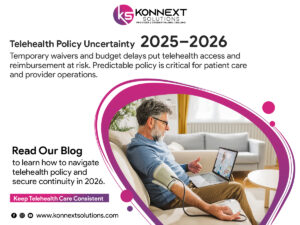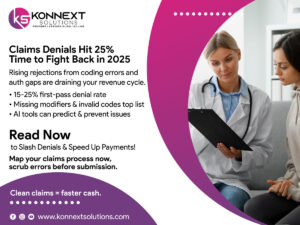The healthcare industry is constantly evolving—driven by emerging regulations, technologies, and clinical coding standards. In 2025, one of the most significant changes on the horizon is the transition to ICD-11 (International Classification of Diseases, 11th Revision). Replacing ICD-10, this update brings expanded specificity, alignment with global healthcare standards, and enhanced data capabilities. However, making this shift without proper planning can disrupt revenue cycles, delay reimbursements, and impact patient care.
To avoid these challenges, healthcare practices must begin preparing now. Below are the essential steps to ensure a seamless and efficient transition to ICD-11.
Why ICD-11 Matters
ICD-11 offers several critical improvements over ICD-10, including:
- More accurate representation of modern clinical knowledge
- Improved global standardization for diagnoses
- Enhanced support for public health reporting and research
- Increased coding flexibility and precision
While these advancements improve healthcare delivery and data quality, the change also brings complexity that demands strategic preparation.
- Assess Your Practice’s Readiness
Begin with a comprehensive assessment of your current systems, staff knowledge, and workflow readiness:
- Are your EHR and billing systems ICD-11 compatible?
- Do your providers and coders understand the new classification structure?
- Is your clinical documentation specific enough to support the granularity of ICD-11?
- Do you have a transition timeline and budget in place?
- What technical or operational barriers do you foresee?
This early evaluation will help you identify gaps, risks, and opportunities for a successful transition.
- Invest in Staff Training and Education
ICD-11 is not just an upgrade—it’s a structural overhaul. Staff at all levels must be well-versed in its format, terminology, and application. Key training components include:
- The foundation and structure of ICD-11 codes
- New coding conventions and clinical logic
- Documentation expectations specific to your specialty
- Hands-on case-based coding scenarios
- Regulatory and payer-specific guidelines
Training should be ongoing and supplemented with refresher modules to keep teams aligned with updates.
- Upgrade and Test Your Technology
Your EHR, billing, and coding software will be the backbone of your ICD-11 operations. Steps to prepare include:
- Coordinating with vendors for software updates and ICD-11 support
- Replacing legacy systems that are not compatible
- Running system tests with ICD-11 codes to detect errors early
- Mapping out dual coding capabilities for a phased transition
- Streamlining workflows for more intuitive documentation
Failing to update your tech stack may lead to claim rejections and compliance issues.
- Revamp Clinical Documentation
ICD-11 demands more granular, structured clinical documentation. Providers must ensure diagnoses, symptoms, and procedures are thoroughly described to meet the coding standards. Consider:
- Implementing ICD-11-ready documentation templates
- Training physicians to capture greater specificity in charting
- Running regular audits and feedback sessions
- Integrating documentation prompts into EHR systems to reduce omissions
High-quality documentation not only supports accurate coding but also improves patient outcomes and reimbursement accuracy.
- Implement a Phased Rollout and Testing Strategy
Avoid disruptions by adopting a phased implementation approach:
- Start with a dual coding period (ICD-10 + ICD-11) to build familiarity
- Gradually shift toward full ICD-11 adoption as confidence improves
- Conduct end-to-end testing of claims, documentation, and billing workflows
- Prepare contingency plans to manage unforeseen issues
- Monitor key performance indicators (KPIs) throughout the rollout
This strategy reduces system shock and helps your team adjust steadily.
Why Partner with Practolytics for ICD-11 Transition?
For many practices, the complexities of ICD-11 are too vast to handle alone. This is where Practolytics becomes an essential partner:
- Deep ICD-11 Expertise
Our certified coding experts are fully trained in ICD-11 structure, logic, and regulatory requirements. - Customized Staff Training
We provide tailored training for your team—covering practical, specialty-specific coding scenarios and compliance tips. - Technology Consultation
We assess your systems and recommend or implement ICD-11-compliant upgrades, ensuring smooth tech performance. - Documentation Strategy Support
Our team helps optimize your documentation workflows, offering templates, EHR enhancements, and internal audit support. - Risk and Revenue Protection
Reduce claim denials, coding errors, and payment delays with our transition guidance and error-prevention protocols. - End-to-End Implementation Support
From planning to full rollout, Practolytics offers continuous support, keeping your team aligned and your operations steady. - Final Thoughts: Take Action Today
ICD-11 implementation is just around the corner. By preparing now—with comprehensive assessments, staff education, upgraded systems, and refined documentation—your practice will be positioned for long-term success.
Partnering with a seasoned expert like Konnext Solutions ensures you navigate this transition without revenue loss, operational disruption, or compliance risks.
Ready to Future-Proof Your Practice?
Let us help you embrace ICD-11 confidently. Contact Konnext Solutions today to schedule a readiness assessment or learn more about our full-suite ICD-11 support solutions.




